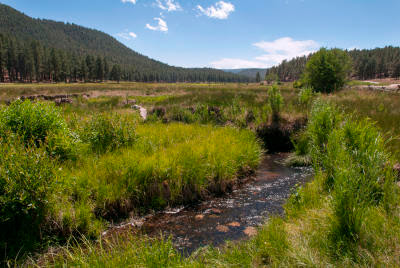The New Mexico Meadow Jumping Mouse
by Casey Ting
Description and
Ecology
The New Mexico Meadow Jumping Mouse (Zapus hudsonius luteus)
is primarily endemic to New Mexico, but is also found in Arizona and a small
part of southern Colorado. In terms of appearance, the Jumping Mouse ranges
from 7.4 to 10 inches long and has yellowish-brown and gray fur, elongated
feet, and a long tail. They are generally nocturnal animals and hibernate
longer than most mammals (about nine months). Their diet consists of mainly
insects (i.e. larvae and beetles), but also includes grass seeds, fruits, and
fungi. Though they create their nests in dry soil, the New Mexico Meadow
Jumping Mice utilize moist wetlands for vegetation purposes. As an animal that
loves water, their habitats are often located near water sources and streams,
ranging from 0.37 to 2.7 acres.
(Jumping Mouse habitat)
Geographic and
Population Changes
Since the 1980s, the number of mouse populations has
decreased significantly. Seventy previously inhabited locations are now
extirpated, leaving only twenty-nine surviving populations since 2005. Of these
twenty-nine populations, all of the habitats do not have a sufficient amount of
land to support the populations. Additionally, eleven of these twenty-nine populations
have been threatened and hurt by water shortages, grazing, wildfire, and post-fire
flooding.
(Jumping Mouse populations in New Mexico & Arizona)
Listing Date and Type
Due to the extreme decline in the mouse populations, the
U.S. Fish and Wildlife Service declared the New Mexico Meadow Jumping Mouse as
“endangered” on July 7, 2014.
Main Threats
The main threat for the New Mexico Meadow Jumping Mouse lies
in habitat modification and fragmentation. Threats like grazing and water
management/usage results in vegetation loss due to mowing and drying of soils.
Additionally, due to climate change, there is a lack of water, drought, and
wildfires that are detrimental to the mice populations. Other threats include
floods, loss of beaver ponds, highway construction, methane development, and
unregulated recreation.
Recovery Plan
The recovery needs of the Jumping Mouse can be categorized
into three factors: resiliency, redundancy, and representation. Because the
populations of the mice are too small, they are not resilient enough to
maintain themselves, especially when factors such as climate change and
wildfire threaten the environment. This stems into low redundancy, in which the
mice populations cannot expand due to their small and isolated condition. While
some diversity of populations is maintained, only half of the conservation
areas have multiple populations. All of these factors contribute to an overall
low species viability, making the probability of the Jumping Mouse becoming
extinct within the next ten years very likely.
The FWS has focused its recovery plan on ensuring that
populations are stabilized, restored, and able to expand. Some of its goals are
to establish partnerships with other organizations to install barriers, modify
livestock management techniques (i.e. fencing, grazing units, water
development, etc.), and protect habitats from the threats mentioned above. A
more research-oriented focus of the recovery plan includes determining the
current the amount of mice populations, researching the genetic diversity of the populations, and studying important aspects of the Jumping Mouse’s life history
(i.e. reproduction, abundance, survival, movement behavior).
For more information, check out this website: http://ecos.fws.gov/tess_public/profile/speciesProfile?spcode=A0BX
Sources:



Great blog! I am saddened to learn that there are so many habitat fragmentation and degradation factors contributing to this species' decline. Hopefully with more research the FWS can successfully increase the New Mexico Meadow Jumping Mouse's numbers. #BIO227Fall2015
ReplyDeleteThe blog looks great! It caught my attention that many other animals like the jumping mouse are also being affected by grazing and wildfires. It is sad to see many species being affected by the actions of humans, but hope this animal will become de-listed. #BIO227Fall2015 -Rosio Villalpando
ReplyDelete